Physical Address
304 North Cardinal St.
Dorchester Center, MA 02124
Based on the German version from Maik Sauer, Jena 2013 (Sauer M. 2013. Statische und dynamische Sonographie der mimischen Muskulatur bei Probanden und Patienten mit peripherer Fazialisparese - Erhebung geschlechtsspezifischer Referenzbereiche [Dissertation] Jena: Friedrich-Schiller-Universität).
These instructions for sonography of the mimic musculature are intended to help sonographers to better understand the very complex sonographic cross-sections of the mimic and mastication musculature and to be able to reproduce them themselves. Because of the special anatomy of the mimic musculature, it is not always easy to differentiate single mimic muscles from the surrounding fat and connective tissue, so all sonographic images are accompanied by a schematic drawing to help make things clearer. To clarify the dynamic changes of the different muscles in motion, each sonographic image in relaxation is accompanied by an image in maximum arbitrary contraction. The anatomic structures marked with numbers are named and explained underneath the appropriate images. To simplify the orientation and to clearly arrange the atlas, only pictures of the right face were used. Furthermore, so-called markers were used, and their function and meaning will be illustrated in detail in section 3 .
Always use a sufficient amount of ultrasound gel. Through this an optimal skin coupling is achieved and compression of the superficial muscles and vessels is prevented. In practice, the use of standoff pads has proven to be unsuitable as they are impractical for the examiner and uncomfortable for the patient. Additionally, image quality is not significantly improved by their use.
If the dynamic characteristics of the muscles are to be assessed, it has proven to be helpful to practice the appropriate movements before the examination. The movements will be explained in detail and be demonstrated by the examiner. As it is quite hard for many people to consciously perform mimic movements, we recommend using a mirror both in the training phase and during the examination itself.
Contractions of the appropriate target muscle might facilitate the clear identification of single muscles for the examiner. As the mimic musculature of elderly and/or obese people often contain a lot of connective and fat tissue and thus appear hyperechoic, identification by contraction is particularly important. The examiner should pay particular attention to ensuring the patient performs the required movement.
If perfusion is to be determined, it should take place before the contraction. Thus changes in blood flow by vascular compression or vasoactive mediators can be minimized.
To make the position of the ultrasound transducer easier to understand, we worked with “markers.” The marker is positioned at the leading end on an L 15-7io “hockey stick” linear ultrasound transducer. To illustrate the position of the ultrasound transducer within the different figures, a green scheme transducer with red head was used for the L 15-7io hockey stick transducer. The red head corresponds to the marker position on the transducer; the green part corresponds to the contact area of the transducer. The marker is represented by a brown line on the side of an L 12-3 linear ultrasound transducer. The corresponding scheme on this transducer is blue with a yellow head. Here, the yellow head corresponds to the marker position on the transducer; the blue part corresponds to the contact area. By using the markers, the examiner is always able to easily orientate him/herself. If the ultrasound transducer is aligned right on the patient, the corresponding structures are on the right side of the ultrasound image.
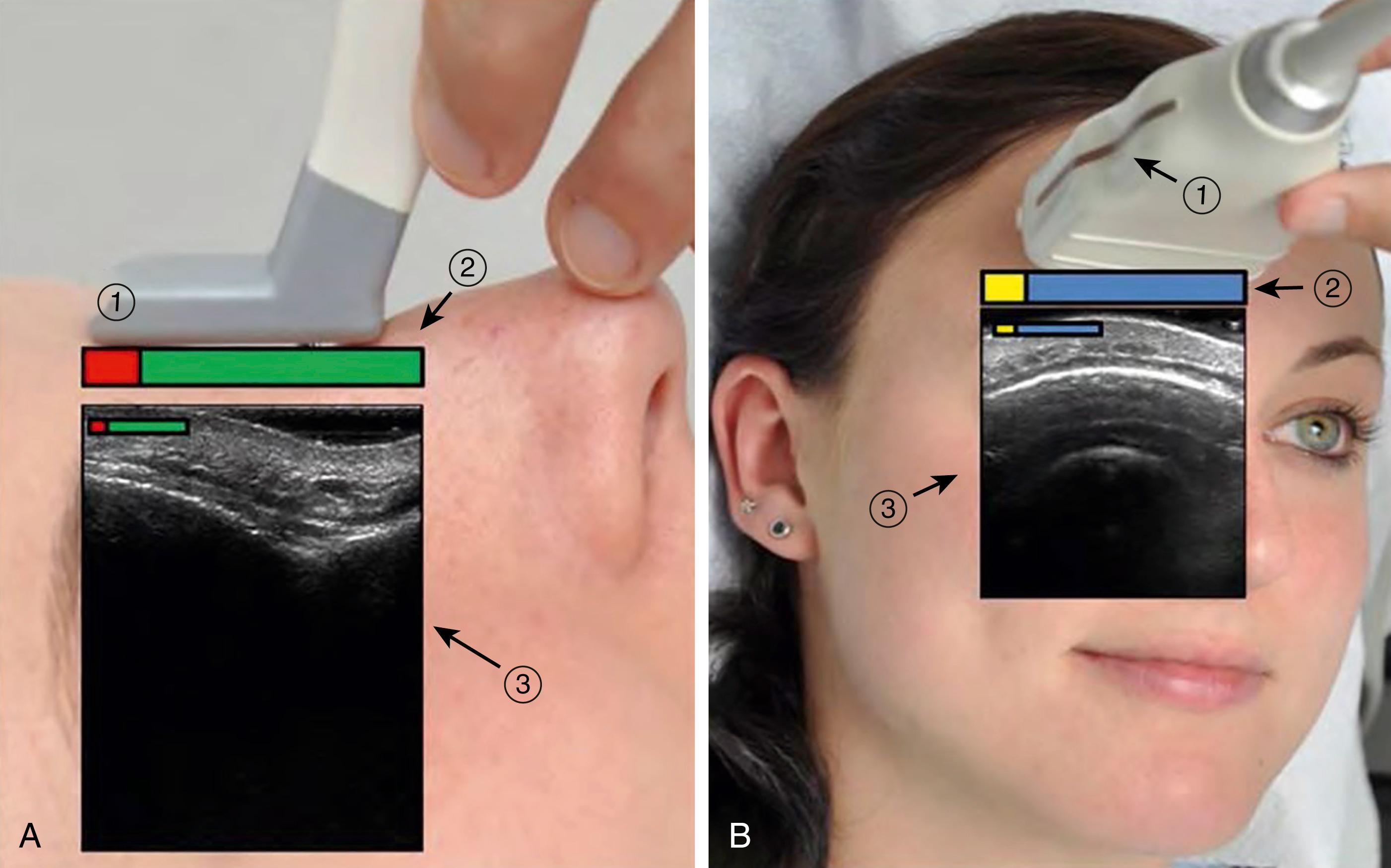
The ultrasound transducer should always be placed vertically on the skin surface, otherwise the respective muscle will be obliquely cut and the corresponding measuring values will be useless. The display of vessels is an exception from the previously described handling of the ultrasound transducer. Because of the variable course of vessels, it might be necessary to swivel the ultrasound transducer from the initial position through the cut of the vessel, i.e., to change the angle of the ultrasound transducer to the skin surface. Thus, it is possible to show a straight, axial cut of the vessel along its course.
| Muscle | Origin/Approach | Innervation/Blood Supply | Function |
|---|---|---|---|
| Muscles of the Skullcap | |||
| M. epicranius | |||
M. occipitofrontalis
|
Origin Over the tendons of adjacent muscles in the range of pars nasalis of os frontale Approach Galea aponeurotica Origin Linea nuchalis suprema Approach Galea aponeurotica |
Innervation
Blood Supply
A. temporalis superficialis
Blood Supply
|
Shifting the scalp Raising the eyebrows and the forehead skin |
| M. temporoparietalis | Origin Fascia temporalis Approach Galea aponeurotica |
Innervation
Blood Supply
|
No appreciable function |
| Muscles in the Range of the Eye Socket and the Palpebral Fissure | |||
M. orbicularis oculi
|
Origin Crista lacrimalis and frontal process of the maxilla Approach Over the raphe palpebralis lateralis on Os zygomaticum Origin Lig. palpebrale mediale Approach Lig. palpebrale laterale Origin Crista lacrimalis of the os lacrimale Approach Canaliculi lacrimales into the pars palpebralis |
Innervation
Blood Supply
|
Firm closure of the palpebral fissure Closure of the palpebral fissure, participation in blinking, and stabilization of the lower eyelid for forming the lacrimal lake Stimulation of lacrimation Outflow of lacrimal fluid |
| M. corrugator supercilii | Origin Os frontale above the sutura frontomaxillaris, glabella, arcus superciliaris Approach Skin above the middle third of the eyebrow, Galea aponeurotica |
Innervation
Blood Supply
|
Shifting the eyebrow skin downwards medial |
| M. depressor supercilii | Origin Os frontale Approach Medial part of the eyebrow |
Innervation
Blood Supply
|
Shifting the skin above the nasal root to a cross fold |
| Muscles in the Range of the Nose | |||
| M. procerus | Origin Os nasale, cartilago nasi lateralis Approach Skin of the glabella |
Innervation
Blood Supply
A. supratrochlearis and branches of the A. ethmoidalis anterior of the A. ophthalmica |
Shifting the skin above the glabella downwards to a cross fold above the nasal root |
M. nasalis
|
Origin Jugum alveolare of the canine until the fossa canina of the maxilla Approach Aponeurosis above the nasal root Origin Above the jugum alveolare of the lateral incisor Approach Skin of the nostril and the nasal septum |
Innervation
Blood Supply
Innervation
Blood Supply
|
Pull the nostril and the nasal tip downwards, slight expansion of the nasal orifice, deepening of the nostril furrow |
| M. depressor septi nasi | Origin Above the alveolar process of the first incisor Approach Cartilaginous part of the nasal septum |
Innervation
Blood Supply
|
Pull down of the nasal tip and expansion of the nasal orifices |
| M. levator labii superioris alaeque nasi | Origin Frontal process of the maxilla, margo infraorbitalis Approach Upper lip, skin of the nostrils |
Innervation
Blood Supply
|
Raising of the nostrils and upper lip, expansion of the nasal orifices |
| Muscles in the Range of the Mouth | |||
| M. orbicularis oris M. buccinator |
Origin Jugum alveolare of the upper and the lower canine Approach Skin of the upper and lower lip Origin Alveolar process of the maxilla in the range of the molars, crista buccinatoria in the range of the mandibular molars Approach Modiolus anguli oris, above the M. orbicularis oris in the upper and lower lip |
Innervation
Blood Supply
Innervation
Blood Supply
|
Whole muscle: Narrowing and closing the mouth opening, producing lip tension Sole contraction of the Pars marginalis: Retract the red part of the lips inside Sole contraction of the Pars labialis: Bulging out the lips Participation in the act of mastication by moving the food from the oral vestibule between the row of teeth and into the oral cavity. Producing tension of the cheeks and the lips |
| M. zygomaticus major | Origin Os zygomaticum before the sutura zygomaticotemporalis Approach Skin of the corner of the mouth and the upper lip |
Innervation
Blood Supply
|
Raising of the corner of the mouth outwards and up, deepening of the nasolabial furrow and the lid furrow |
| M. zygomaticus minor | Origin Os zygomaticum medial of the M. zygomaticus major Approach Skin of the sulcus nasolabialis |
Innervation
Blood Supply
|
Raising of the corner of the mouth outwards and up |
| M. risorius | Origin Facia masseterica Approach Skin of the upper lip, mucous membrane of the vestibulum oris, modiolus anguli oris |
Innervation
Blood Supply
|
Movement of the corner of the mouth to lateral, deepening of the nasolabial furrow, production of the cheek dimple |
| M. levator labii superioris | Origin Margo infraorbitalis of the maxilla above the foramen infraorbitale Approach Skin of the upper lip and the nostril, M. orbicularis oris |
Innervation
Blood Supply
|
Raising of the upper lip, producing a fold above and sidewise to the nostril |
| M. levator anguli oris (M. caninus) | Origin Fossa canina below the foramen infraorbitale Approach Skin and mucous membrane of the corner of the mouth, Modiolus anguli oris, M. orbicularis oris |
Innervation
Blood Supply
|
Raising of the corner of the mouth cranial-medial |
| M. depressor anguli Oris (M. triangularis) M. depressor labii inferioris (M. quadratus inferioris) |
Origin Basis mandibulae of the tuberculum mentale up to the jugum alveolare of the first molar Approach Skin of the corner of the mouth, Modiolus anguli oris Origin Basis mandibulae below the foramen mentale (connection to the platysma) Approach Skin and mucous membrane of the lower lip, skin of the “chin bulge”, M. orbicularis oris |
Innervation
Blood Supply
Innervation
Blood Supply
|
Movement of the corner of the mouth downwards Movement of the lower lip below and lateral, bulging the red part of lips |
| M. mentalis | Origin Jugum of the lateral incisor of the mandibula Approach Skin of the chin |
Innervation
Blood Supply
|
Shift skin of chin upwards |
| Muscles in the Range of the Outer Ear | |||
| M. auricularis anterior | Origin Fascia temporalis, galea aponeurotica Approach Spina helicis of the ear |
Innervation
Blood Supply
|
Minimal forward tension of the ear |
| M. auricularis superior | Origin Galea aponeurotica Approach Rear surface of the ear in the range of eminentia scaphae and the eminentia fossae triangularis, spina helicis |
Innervation
Blood Supply
|
Minimal upward tension of the ear |
| M. auricularis posterior | Origin Mastoid process, Linea nuchalis superior Approach Eminentia conchae of the ear |
Innervation
Blood Supply
|
Minimal backward tension of the ear |
| Muscles of the Neck | |||
| Platysma | Origin Basis mandibulae Approach Skin of the upper thoracic area |
Innervation
Blood Supply
|
Facial part: Pulling down the corners of the mouth to lateral Part of the neck: Shifting the skin of the mandibula; Tension of skin and subcutaneous tissue |
| Muscle | Origin/Approach | Innervation/Blood supply | Function |
| M. Masseter | Origin Pars profunda: Facies temporalis and inner side of the temporalis process of the os zygomaticum Pars superficialis: Facies lateralis and temporalis process of the os zygomaticum Approach Pars profunda: Ramus mandibulae up to the basis of the coronoideus process and the condylaris process Pars superficialis: Tuberositas masseterica on the surface of the angulus mandibulae |
Innervation
Blood Supply
|
Strong lifting (adduction) of the lower jaw, support of the protrusion of the lower jaw |
| M. Temporalis | Origin Linea temporalis inferior of the facies externa of the os parietale and the facies temporalis of the os frontale, pars squamosa of the os temporale, facies temporalis of the os zygomaticum, facies temporalis of the os sphenoidale up to the crista infratemporalis Approach Coronoideus process of the mandibula to the trigonum retromolare |
Innervation
Blood Supply
|
Ambilateral: Strong lifting (adduction of the lower jaw, retrusion of the lower jaw, support of protrusion (anterior part) Unilateral: Stabilization of the caput mandibulae, shift of the caput mandibulae forward and rotation to the contralateral side |
| M. Pterygoideus Medialis | Origin Pars medialis: In the fossa pterygoidea on the facies medialis of the lamina lateralis Pterygoidei process of the os sphenoidale Pars lateralis: Facies lateralis of the lamina lateralis processus pterygoidea of the os sphenoidale, processus pyramidalis ossis palatine, tuber maxillae Approach Tuberositas pterygoidea on the inner side of the angulus mandibulae |
Innervation
Blood Supply
|
Ambilateral: Lifting (adduction) and protrusion of the lower jaw Unilateral: Grinding movement, shift of the caput mandibulare forward and rotation to the contralateral side |
| M. Pterygoideus Lateralis | Origin Caput superius: Facies temporalis and crista infratemporalis of the ala major of the os sphenoidale Caput inferius: Facies lateralis of the lamina lateralis processus pterygoidea of the os sphenoidale Approach Caput superius: Fovea pterygoidea, discus articularis Caput inferius: Fovea pterygoidea |
Innervation
Blood Supply
|
Caput superius: Ambilateral: Fixation of the caput mandibulae Unilateral: Grinding movement, stabilization of the resting caput mandibulae Caput inferius: Ambilateral: Initial stage of jaw opening Unilateral: Grinding movement |
The ultrasound transducer is moved orthogonal along an imaginary line which runs axial to cranial through the pupil. Two cm above the osseous orbita rim, the ultrasound transducer is placed vertically on the skin surface. As there are strong interindividual variations in the form of the eyebrows, they should not be used as landmarks or there may be overlaps of the venter frontalis by muscle fibers of the M. orbicularis oculi or the M. corrugator supercilii. Please note not to move the ultrasound transducer too far to cranial as the venter frontalis becomes thinner and is increasingly penetrated by connective tissue.
The venter frontalis of the M. occipitofrontalis is anechoic underneath the subcutis. There is a hyperechoic tissue-related boundary layer underneath the muscle which is not always demonstrable sonographically. The border of the Os. frontale is visible as a white reflection.
“Raise your eyebrow.”
There is a significant thickening during the contraction as well as a decrease of the echogenicity.
The ultrasound transducer should be applied without pressure as the muscles will otherwise be compressed and the measured values might be significantly distorted. To compensate for the contour of the skull, it is important to use a lot of gel. Occasionally, significant septations of the muscle occur. Contraction can aid in the evaluation of the largest diameter. The previously described periost directly above the os frontale also thickens during contraction. This is not caused by muscle fibers but by a kind of traction in the direction of the skin surface by the contracting venter frontalis.
There might be overlaps of the venter frontalis by muscle fibers of the M. orbicularis oculi or the M. corrugator supercilii if the ultrasound transducer is wrongly positioned.
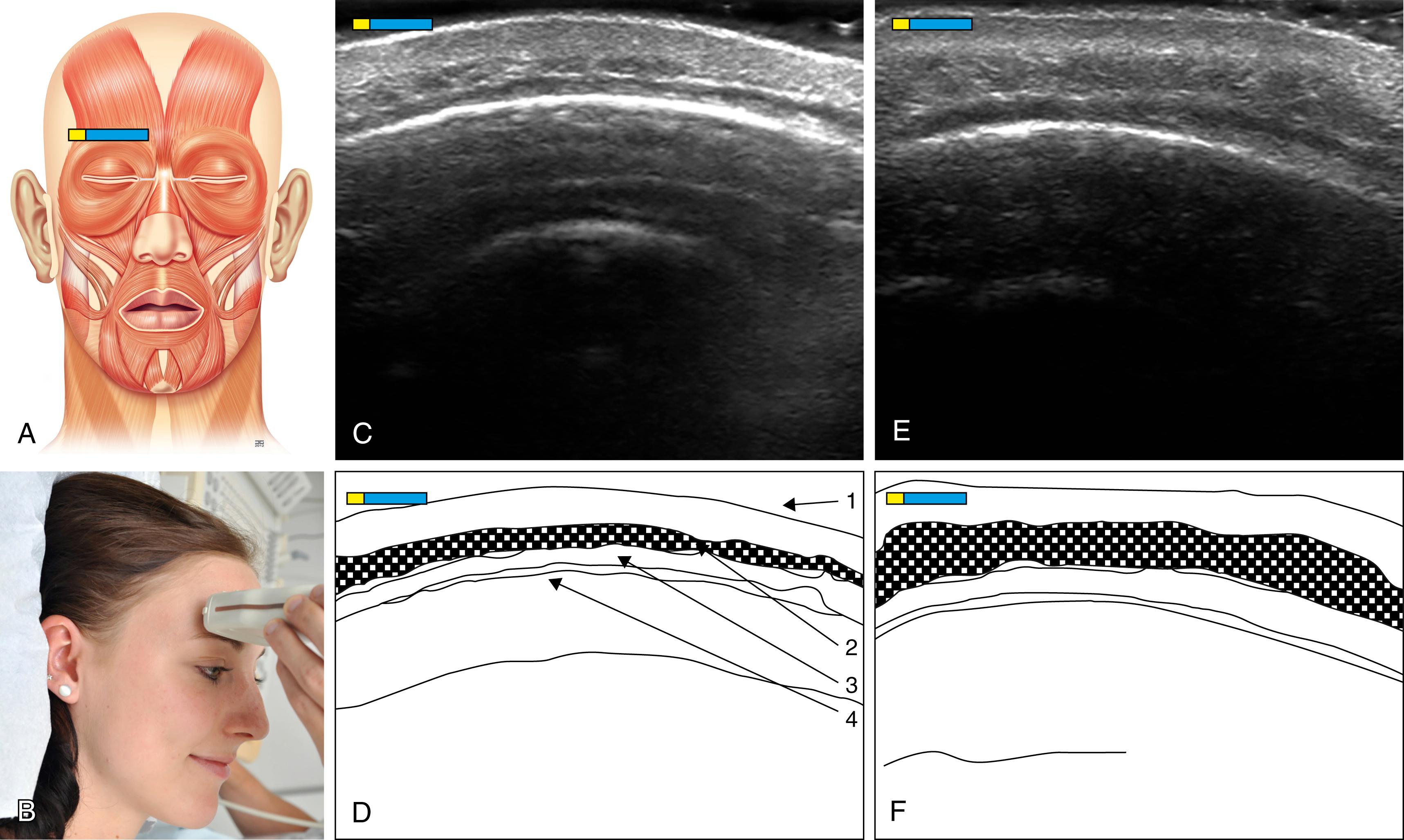
The ultrasound transducer is moved parallel, similar to the procedure for finding the venter frontalis of the M. occipitofrontalis, starting from the level between the pupils in the median plane at the level of the eyebrows. The head of the transducer should be gently positioned at a right angle between the eyebrows. The eyebrows are a landmark but only give a rough guideline. The bony landmarks are the ends of the arcus superciliaris on both sides.
Sonographically, the muscles appear mostly triangular and with little resonance underneath single muscle fibers of the M. depressor supercilii. Deeper, the border of the calotte with acoustic shadow underneath can be seen. Sonographic lead structures are the previously mentioned medial ends of the arci superciliares on both sides.
“Knit your brows” (as if angry).
There is significant thickening and medial shift during the contraction, as well as a decrease of the echogenicity. If the movement is executed correctly, vertical skin folds appear.
To compensate for the contour of the skull, it is important to use a lot of gel. The ultrasound transducer should also be positioned without using pressure. The M. corrugator supercilii is differentiated by some hyperechoic connective tissue fibers from the M. depressor supercilii, which is superior to it.
The muscle can be clearly identified by contraction. If the ultrasound transducer is put on too far cranial, the muscle can be overlapped by fibers of the M. frontalis. If the ultrasound transducer is put on too far caudal, cross-sections of the M. levator labii superioris alaeque nasi will be seen on the left and right side of the nasal bone.
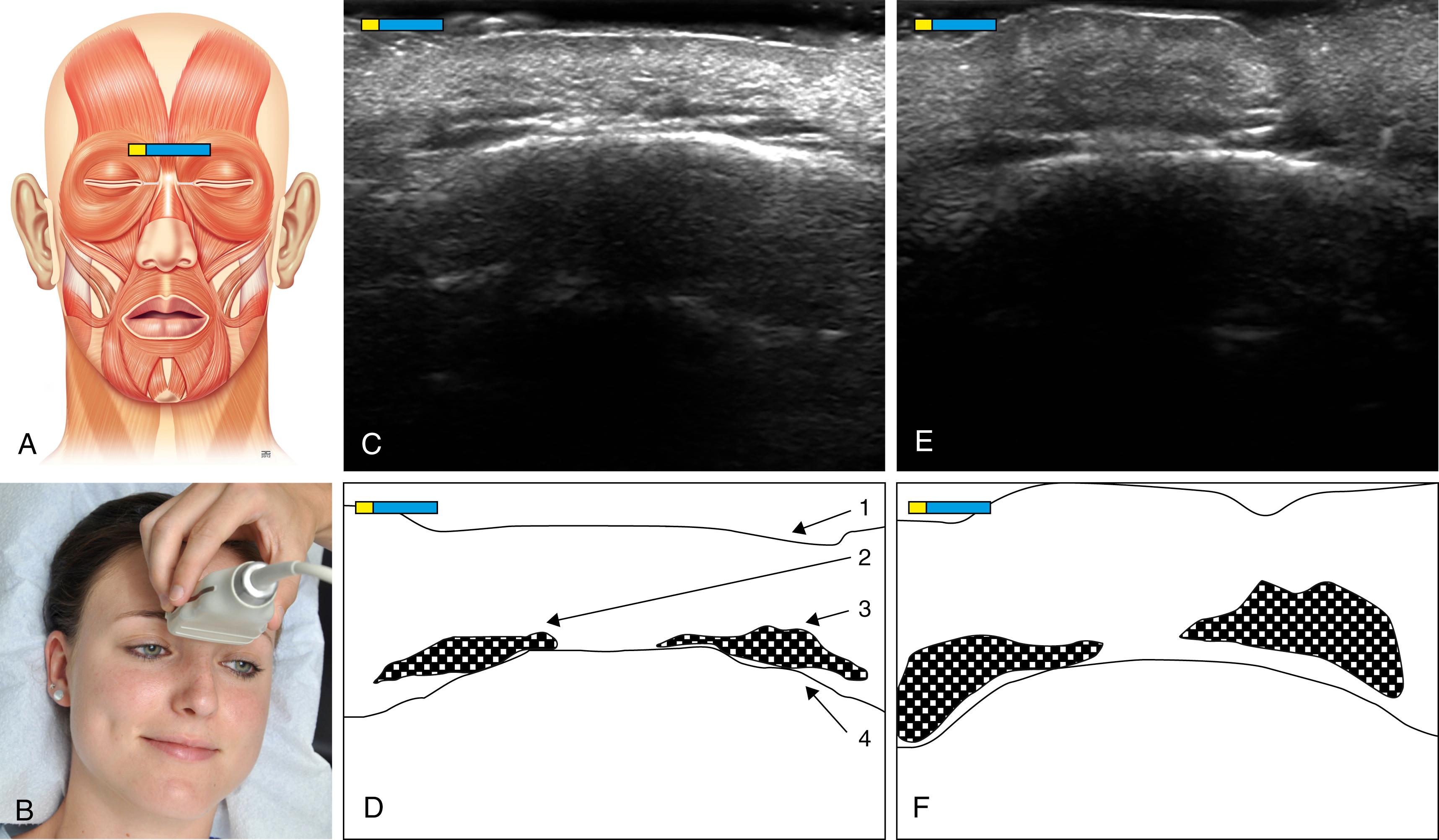
The ultrasound transducer should be placed vertically onto the skin surface in the median plane in the transition between the os frontale and os nasale.
The nasal bridge and the os frontale, as well as the concave curvature between the two bony structures, function as lead structures.
“Sniff.”
There is significant thickening and increase of the echogenicity of the muscle during contraction. There are significant horizontal creases on skin level.
In order to fill the transition zone between the os frontale and the os nasale, a lot of gel should be used. The ultrasound transducer should always be placed exactly on the median plane or there could be overlapping with fibers of other muscles which are topographically nearby.
If the ultrasound transducer is not placed exactly on the median plane, there could be overlapping with muscle fibers of the M. orbicularis oculi, M. depressor supercilii, or M. corrugator supercilii, depending on the degree of deviation.
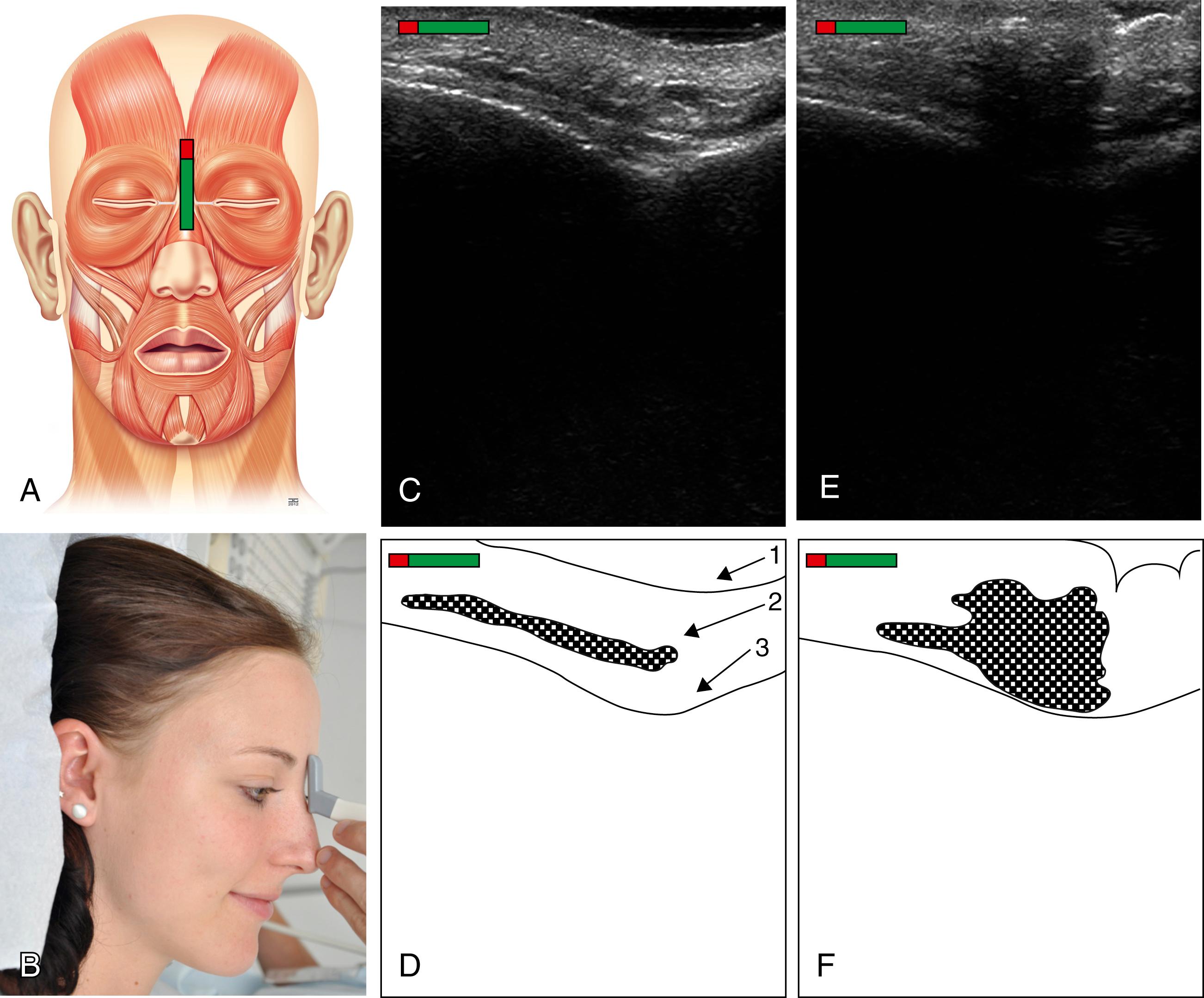
The ultrasound transducer should be placed onto the skin upright level with the pupil above the frontal process of the os zygomaticum. The angle of the ultrasound transducer should always be placed such that ultrasonic waves do not hit the eye directly.
Strong white reflection of the margo lateralis of the orbita with following acoustic shadow. The thin M. orbicularis oculi is a small, low echo stripe and runs from lateral across the orbita rim.
“Close your eyes.”
The strongest thickening of the M. orbicularis oculi is mainly directly above the lateral orbita rim.
Using too much pressure when positioning the ultrasound transducer onto the soft muscle will distort the results. Therefore it is necessary to use a lot of gel. To avoid damaging the retina through ultrasonic waves, the eye should not be examined with ultrasound.
By choosing the focus in a very superficial level, the muscle can be easily identified. In extreme cases, such as in people with an extremely high BMI or patients with chronic facial nerve paresis, the identification might be more difficult. In these cases, asking the patient to contract the muscle or slightly shifting the ultrasound transducer is helpful. The hyperechoic thresholds of the muscle can be displayed easily and clearly identified.
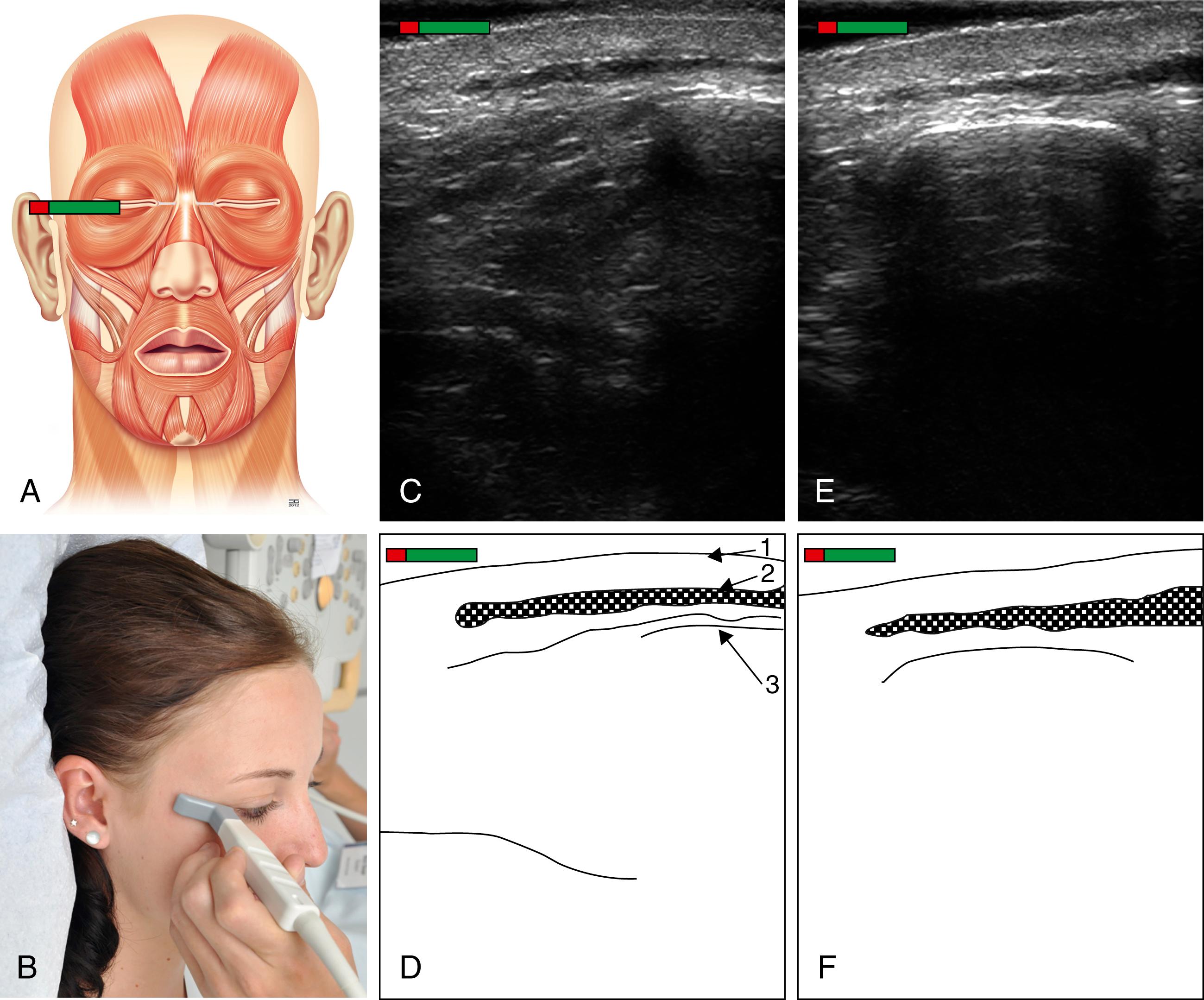
The level visualized by ultrasound runs along the os nasale and frontalis maxillae process between a median point on the upper, distal end of the os nasale and the ala nasi of the corresponding side.
The upper, distal end of the os nasal and the cartilagines alares minores of the corresponding side function as sonographic lead structures. The M. nasalis is anechoic and clearly visible in the subcutis. Deeper, the borders of the different bony and cartilaginous structures of the nose are seen.
“Sniff.”
There is significant thickening during the contraction as well as a shortening of the muscle. Clearly visible skin folds are raised during the contraction.
To avoid compression of the muscle and to compensate for the contour of the nose, a lot of gel should be used. The muscle can be easily identified by contraction.
If the ultrasound transducer is placed too lateral, there could be confusion with M. levator labii superioris alaeque nasi.
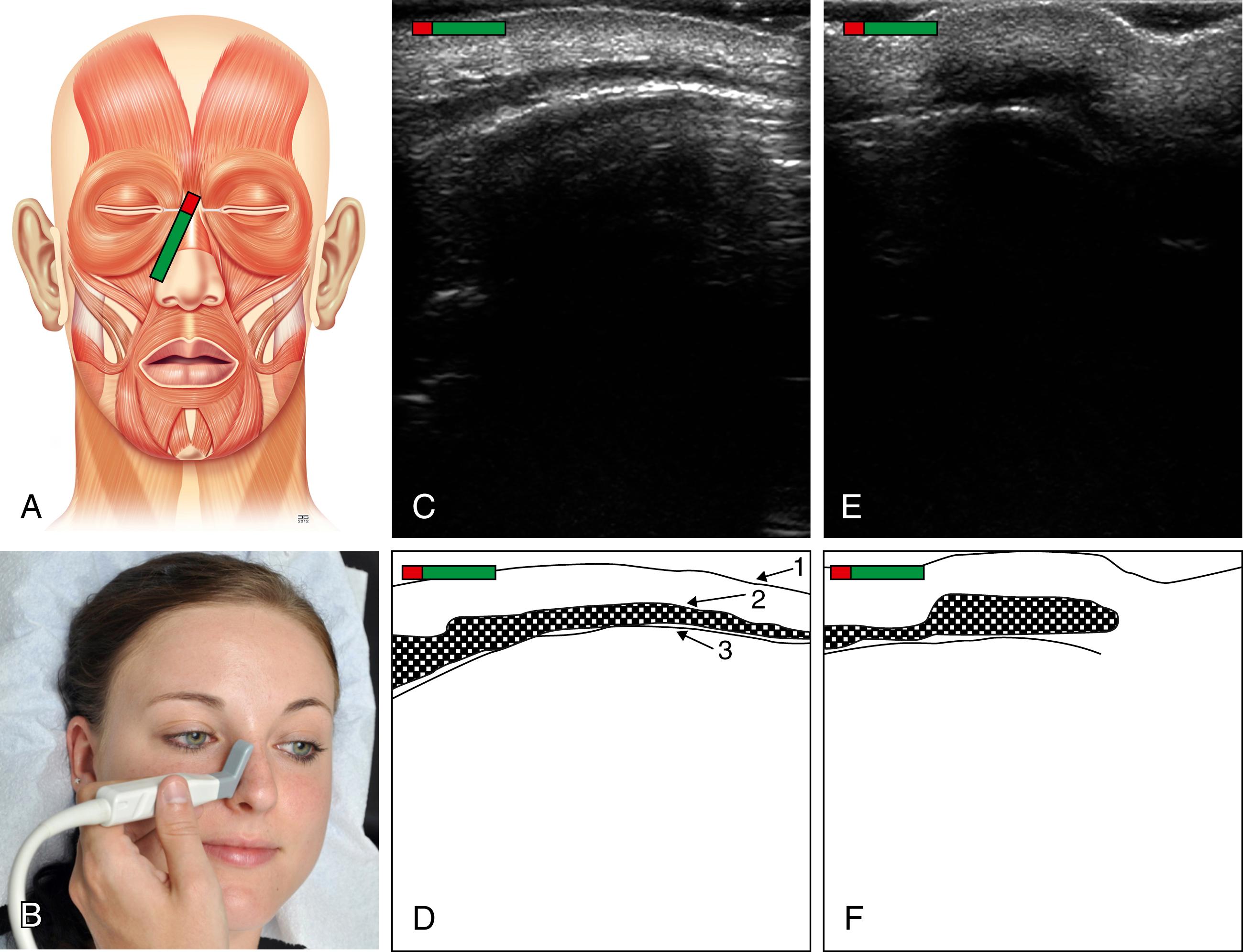
Become a Clinical Tree membership for Full access and enjoy Unlimited articles
If you are a member. Log in here